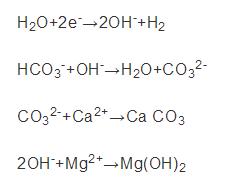针对循环水冷却水系统传统的电吸药剂水质管理存在的缺点,结合本公司循环水电吸附改造情况,附技介绍了电吸附技术在循环水处理中的术石应用,对相关运行数据进行了对比和总结,化循环水研究表明电吸附吸附技术可以代替化学药剂法应用于循环水系统,处理并具有化学药剂法不可替代的应用研究优点。
一、电吸前言
循环水是附技石化企业中重要配套公用工程,主要是术石以水作为冷却介质并循环使用的一种冷却运行系统。在开放式循环水系统中,化循环水由于循环水不断蒸发、处理无机离子和有机物质浓缩、应用研究微生物及藻类滋生等诸多原因,电吸产生严重的附技结垢、粘泥增生和设备腐蚀等水质问题:(1)结垢:主要是术石碳酸钙不断沉积结垢,导致换热器传热效率降低甚至管道被堵。(2)粘泥增生:开放式循环水冷却塔适合微生物增生,导致换热器中管路堵塞,降低了冷却作用还造成粘泥腐蚀。(3)设备腐蚀:循环水系统中的碳钢、不锈钢、铜材质在长期循环水运行会形成溶解氧腐蚀、垢下腐蚀、氯离子腐蚀等各类腐蚀。
二、化学药剂法
目前传统的水处理方法有化学药剂法,通过连续投加缓蚀剂、阻垢剂或缓蚀阻垢复合剂(一般情况为富含有机磷或无机正磷的聚合物),定期或连续投加氧化性杀菌剂,冲击性投加非氧化杀菌剂,结合旁滤、定期排污置换方式结合控制水质,并按照《GB50050-2017工业循环冷却水处设计规范》要求进行水质管理。
化学药剂法虽然能够满足循环水水处理的指标要求,但也有较大的缺点:(1)缓蚀阻垢剂以含磷为主,排污时对环境造成一定污染,且磷元素本身会有利于微生物的增生,增加杀菌灭藻的难度。(2)化学药剂具有时效性,跟投加浓度和成分有关,且在水体中有效成分易分解,易失效,效果不稳定。(3)氧化性杀菌剂一般为含氯杀菌剂,余氯过高会增加碳钢腐蚀,非氧化杀菌剂,具有一定毒性,对水生动物有危害。(4)为节约用水,一般循环水高浓缩倍数运行,阻垢效果会变差,循环水仍存在结垢的风险。
总之,化学药剂法不能从根本上解决循环水系统微生物粘泥、结垢及腐蚀问题,无法进一步节约用水,且容易导致二次污染。
三、电吸附技术
电吸附技术耦合了电化学理论与吸附分离技术,广泛用于水的除盐、去硬等。
循环水通过电吸附后在阴极进行阴极电化学反应如下:

在阳极进行阳极电化学反应如下:

反应后阴极板形成钙垢和镁垢,同时水得到电子生成氢气,将容易结垢离子进行有效去除,同时在阳极进行氧化反应,生成臭氧和氯气等气体。
四、电吸附在石化循环水场的应用研究
(一)设备改造
以1 500m3/h循环水场作为电吸附设施研究试点:循环水量为1 500m3/h,温差为5℃,保有水量为300 m3。
(1)循环水经过生产装取热后返回冷却塔回水压力为0.2-0.3 Mpa,利用该压力取循环水量的2%-5%通过电吸附设备后再返回循环水系统中,循环水经过电吸附设备处理后水体连续经过净化循环而不断得到处理。
(2)本次改造试验使用上海复禹环保有限公司的2套电吸附设备,具体改造内容如下:(1)在一期循环水回水管路上增加一DN150管线,分出2个DN80(89*5)分支,并各设置一个切断阀门。(2)在以上2个支路上安装2套电吸附循环水处理设施,使循环水通过回水压力通过该设备,水体在电吸附技术设备中进行电吸附反应后返回循环水集水池,循返回线需要深度到集水池液面以下0.5 m。(3)每台设备增加1套流量计用于监测通过设备流量情况,并根据一期循环水的循环水和水质情况调整该流量,同时在循环水挂片器监测循环水腐蚀情况。

(二)水质检测
试验确保循环水水质符合GB50050-2017相关水质标准,主要指标及检测方法见表1:

声明:本文所用图片、文字来源《科学咨询(科技·管理)》,版权归原作者所有。如涉及作品内容、版权等问题,请与本网联系删除
相关链接:氢气,磷元素,碳酸钙